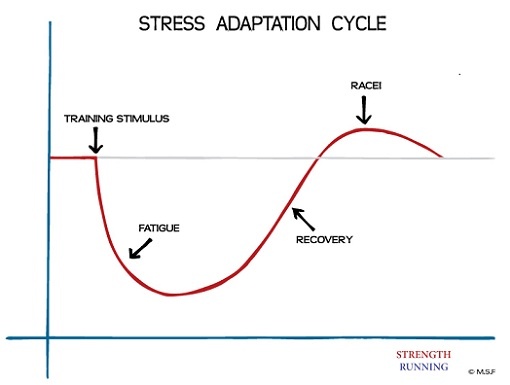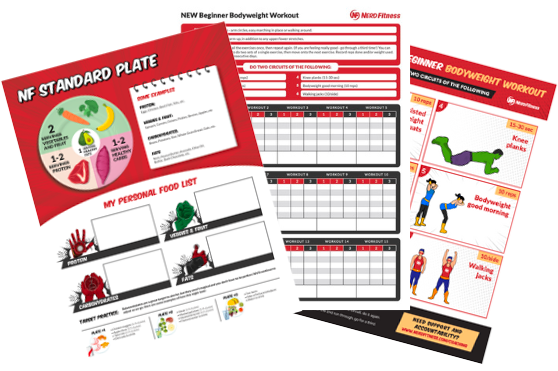
This is a guest post from my good friend Jason Fitzgerald over at StrengthRunning.com.
As a kid, I used to debate really important questions, like: Which X-Men superhero would I be?
And over and over again, I always came back to Wolverine. The claws! The mutant healing factor! The adamantium skeleton!
I loved Wolverine because his mutant power is one that we can improve ourselves: his enhanced recovery.
While we can’t fuse our bones with a virtually indestructible metal alloy that makes us practically invincible, we can improve our own healing factor so we can work out more without getting hurt.
For many of us, overuse injuries stop us in our tracks. Whether it’s that weird pain in our back when lifting or a burn in our Achilles while running, injuries are an unfortunate reality for Rebels who are leveling up their lives.
Unfortunately, this isn’t a rare occurrence. Some reports place the annual injury rate for runners at over 50%, and over 40% for triathletes. As a coach, this is unacceptable to me.
So what should we do? Stop exercising because we’re afraid of getting hurt? There’s no fun in that.
Instead, you can change how you exercise to lower your injury risk – so you can keep running, jumping, lifting, throwing, and playing.
Wolverine has unparalleled regenerative capabilities – and so can you.
But first…
What Exactly Are Overuse Injuries?

Overuse injuries are what happens when we fall victim to the “3 Too’s” – too much (exercise), too soon (before you’re ready), too fast (at too high of an intensity).
Whether that’s running, Ultimate Frisbee, or golf, overuse injuries can happen if you go all in without letting your body recover in between exercise sessions.
Now, instead of calling it an overuse injury, let’s call it a “repetitive stress injury.” Doing something over and over again causes stress – which isn’t necessarily a bad thing – but if we do it too much without enough rest, we could get hurt.
Not all injuries are repetitive stress injuries, though. If Magneto uses his power to extract the iron from your body, that’s not an overuse injury. That’s an acute injury and you need to get to a hospital right now.
Here are some of the most common repetitive stress injuries and the type of athlete they usually afflict:
- Tennis Elbow (tennis players, weight lifters, those with jobs that have repetitive motions like carpenters, plumbers, or butchers)
- Patellar (knee) Tendinitis (weight lifters, basketball players, anyone who jumps a lot)
- IT Band Syndrome (cyclists, hikers, and runners)
- Achilles Tendinopathy (runners and hikers)
- Plantar Fasciitis (runners, hikers, and those who spend a lot of time on their feet)
You might be asking yourself – do injuries only happen to endurance specialists? The answer is nope!
Overuse injuries are common among any type of athlete, not just those who prefer endurance sports like running, cycling, or swimming. In fact, they’re the most common injury among weightlifters, too!
Since these types of injuries are repetitive, those of us who specialize in a single sport are more at risk. I train for marathons and I’m more likely to get an overuse injury than someone who just runs casually a few times a week.
Staci trains for weightlifting competitions so she’s more likely to get a repetitive stress injury than a Rebel who only does bodyweight workouts twice a week.
Even X-Men can be at a higher risk for repetitive stress injuries. If Gambit keeps throwing playing cards all day, he could develop tennis elbow. Nightcrawler’s prehensile tail could get tendinitis if he spent hours crawling and swinging in battle with the Brotherhood of Mutants.
Now that we know what repetitive stress injuries are, how do you actually avoid them?
Recovery 101

There are specific ways you can adjust your exercise routine (like doing neutral grip chin ups in the PLP program, for example) to help prevent injuries. However, none of them would work if you didn’t allow yourself time to recover in between workouts!
Without recovery, you can’t adapt to your workout and get stronger or faster. After all, it’s in the recovery period that your muscles rebuild faster and stronger – not the workout itself.
I’m a nerd and love graphs so here’s how this adaptation principle works (for strength training, replace “race” with “next workout”):

See how important recovery is?
If you follow every workout with a night of hard drinking and only four hours of sleep, you’re never going to see any progress.
While it would be awesome to have Wolverine’s healing factor, it’s best to listen to my college coach’s advice: “you can’t burn the candle at both ends.”
So how exactly do you get the maximum amount of recovery in between workouts? Just three easy payments of $29.95 for RecoverPRO-X2 JAKKD!
There are no shortcuts to recovery, performance, or getting in shape. If you’re paying out the nose for wacky supplements, you should stop that. Seriously.
There are three aspects of recovery that have the biggest impact on how you feel day to day, so here we go.
1) SLEEP! Getting enough sleep is hands down, absolutely, positively the most important thing you can do to recover in between your workouts. Sleeping as much as you need helps your muscles repair the damage that you inflicted during the workout (this “tear down, then rebuild even stronger” is what fuels the adaptation process and helps you get stronger and faster).
Not getting enough sleep has a huge number of negative physical side effects, like decreased muscle mass, poor recovery, lower testosterone and human growth hormone levels (important for women, too!), and a lot more. That’s bad news bears.
If you’re exercising a lot, you might need more than usual. Experiment with what works best for you, and check out the Nerd Fitness Guide to Sleep.
Diet Matters! Eat a conventional diet of fried food, simple sugar, and virtually no vegetables, and your body won’t be getting the basic building blocks it needs for that rebuilding process. Imagine trying to build a house without any wood? Just imagine it! I feel like I’m taking crazy pills!
If you exercise a lot, especially if you run, you’ll need more carbohydates. But that doesn’t mean you can gorge on Oreos and sugary sports drinks.
Instead, use the paleo diet principles and add nutrient-dense carbohydrates like sweet potatoes, fruit, wild rice or quinoa.
The RIGHT Training. Recovery is only going to happen if your workout is appropriate for you. New to weight lifting? You shouldn’t start out with six max effort deadlifts. Just started running? Probably not a good idea to sign up for a marathon in three weeks.
Your workouts should always build on themselves. You start at a level that’s appropriate for you and gradually over time your workouts get harder and harder. This is exactly how fellow Rebels see enormous success – they follow good training that progresses over time. It’s tempting to get excited and do too much too soon, but resist the urge.
Once you’re sleeping enough, eating right, and training appropriately, it’s time to learn smart injury prevention strategies that you can use within your workouts.
These are the same strategies Professor X uses with his team. Trust me, I called him to verify.
4 ways to actually prevent injuries

Repetitive stress injuries happen for a lot of reasons, but the most common are because of poor form, no progression, lack of strength, and no variety. And usually because of a combination of all four!
If you improve each one, your injury risk will plummet. While you won’t be as indestructible as Wolverine, you won’t get hurt nearly as much as the non-Rebel who doesn’t plan his workouts well.
1) Proper form is critical if you’re a weight lifter, cyclist, runner, or any athlete in between. The wrong movement repeated hundreds (or even thousands) of times is a serious injury in the making.
- Lift weights? Learn how to properly do a squat, pull up, and every other exercise you do in the gym.
- If you ride bikes, get a professional bike fitting.
- Are you a runner? Learn how to not suck at running.
As a running coach, I see problems with running form all the time. And it transcends to other sports too. In the weight room I see people doing technical lifts with horrible form. Helloooo back injury!
Exercising correctly is admittedly the least sexy topic ever (almost ahead of taxes), but it’s foundational. It’s basic. It helps you do whatever exercise you love – running, lifting, Parkour – without problems. And hopefully, without injuries.
2) Progression is moving through every exercise at a level that’s appropriate for you.
Start at Level 1. Then level up to Level 2 when you’re ready. That’s progression at its finest. It’s one of the really effective ways I was able to go from chronically injured to healthy.
Improve your training gradually, consistently, and incrementally. It’s the smartest (and most often IGNORED) training principle that will help you stay healthy. It’s why Steve started with just 10 push ups on his first day of PLP training. It’s why you don’t start with a 20 mile run, but rather going for a walk.
And my suggestion is to always err on the side of doing too little than too much. I’d much rather you be 5% under-trained than hurt and unable to exercise at all.
3) Get strong! Like, really strong. Strength helps prevent injuries no matter what activity or sport you enjoy.
- Parkour athletes won’t fatigue as quickly and will have the strength to avoid any clumsy falls or muscle strains.
- Runners who lift weights are less likely to suffer an overuse injury.
If you haven’t started with strength exercises yet, yesterday is the best time. But today is fine, too! Always use good form while doing strength work and start with manageable workouts like bodyweight exercises.
That’s right, form and progression, again! All of these principles are related – once you implement them into every one of your workouts you’ll be far less likely to get injured.
4) Variety is the spice of life and it should be a big part of your exercise program, too. As a coach, I see runners making this running mistake all the time by doing the same distance, at the same pace, in the same shoes on the treadmill every day.
You might be making the same mistake as a weight lifter, doing the same exact workout in the gym every single week. No wonder you’re not improving!
Every subtle change you implement is a different stress that’s applied to your body. Exercises like squats have almost countless variations that help you gain strength and work your body in different ways.
Since repetitive stress injuries are by definition repetitive, variety is a way to reduce that repetition. Here’s a good example for the Rebels who like running: let’s say your knee hurts after a 5 mile run on a hilly route on the roads.
The next time you go running, wear a different pair of running shoes (to slightly alter your running form) on a flat 3 miler on a softer surface like a dirt path. That’s a totally different type of run than your hilly 5 miler on the roads.
You can do the same with any type of workout: vary the stress, reduce the repetition.
These strategies are so effective at injury prevention that I use them with my runners to help them stay healthy long-term (and myself, too – I’ve only been hurt once in the last five years!). It’s a much better approach than bad injury advice like “stretch more!” and “run intervals so you feel like you’re dying!”
Ouch.
What injuries do you struggle with?

Let’s exercise a little smarter, recover a little better, and improve our healing factor just like my favorite X-Men: Wolverine.
With injury rates as high as they are, I’m sure you have a story about an injury you’ve experienced while leveling up your life.
Let us know in the comments so we can learn from each other.
And if you have any questions, leave them below and I’ll do my best to reply to each one!
-Jason
PS from Steve: We actually started planning this post months ago, and then my friend Brett from Art of Manliness ran a post about recovery and wolverine too. It seems like great nerds think alike! While this is merely a coincidence, both articles compliment each other nicely! 🙂
Jason Fitzgerald is a 2:39 marathoner and USA Track & Field certified running coach. Get more running advice at Strength Running – or sign up for two free presentationson injury prevention, mistakes we make, and how you can stay healthy like Wolverine!
###
photo source: JD Hancock: Ill-gotten, Andrew Becraft: Medic Sigfig, momo: wolverine hug, Nathan Rupert: wolverine, Nicolo Paternoster: Tightrope


